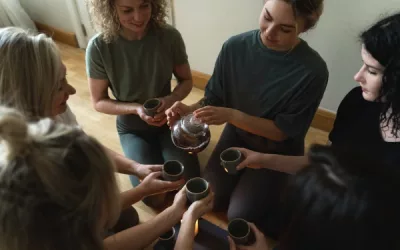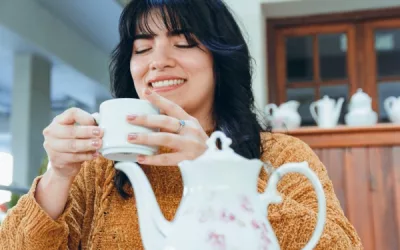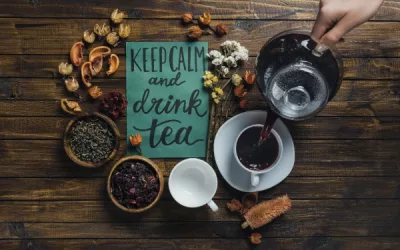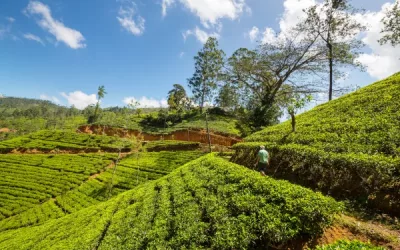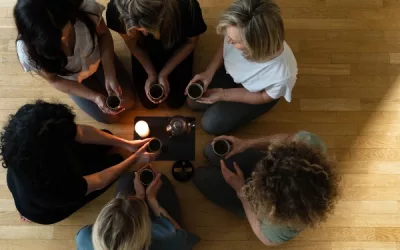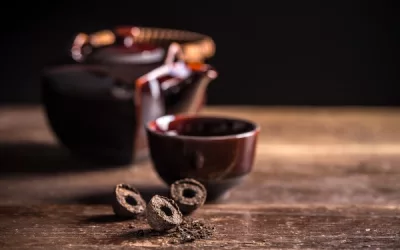Did you know that tea is the most widely consumed beverage in the world after water? Beyond its refreshing taste, tea is woven into the fabric of cultures worldwide, boasting a history rich in tradition, trade, and health benefits. This article serves as your ultimate guide to tea, exploring its fascinating origins, diverse types, and profound cultural significance. Whether you’re a novice or a connoisseur, understanding tea’s multifaceted role in our lives will deepen your appreciation for this beloved beverage. Let’s sip in!
Table of Content
What is tea?
Tea is a popular beverage made by steeping the processed leaves, buds, or twigs of the tea plant (Camellia sinensis) in hot or boiling water. It’s one of the most widely consumed drinks in the world, second only to water.
There are several main types of tea, all derived from the same plant but processed differently:
- Black tea: Fully oxidized leaves, resulting in a strong, bold flavor.
- Green tea: Minimally oxidized, with a fresher, more vegetal taste.
- Oolong tea: Partially oxidized, with flavors ranging between black and green tea.
- White tea: Made from young buds and leaves, very lightly processed.
- Pu-erh tea: Aged and fermented, often sold in compressed cakes.
Tea can be served hot or cold and is often consumed with additions like milk, sugar, honey, or lemon. It contains caffeine, although generally less than coffee, and is rich in antioxidants.
Many herbal infusions, such as chamomile or peppermint, are also commonly referred to as “tea,” although they don’t actually contain leaves from the Camellia sinensis plant.
What is the history of tea?
Tea holds a storied past that dates back thousands of years. The origins take root in ancient China. According to legend, Emperor Shen Nong discovered tea in 2737 BCE when a tea leaf landed in his boiling water. This delightful accident marked the beginning of tea’s journey across the globe.
Over time, tea rituals became integral within Chinese culture. Tea ceremonies celebrated the intricate preparation and enjoyment of tea. Tea’s benefits secured its status as China’s staple beverage.
From China, tea traveled along the Silk Road and maritime routes to reach the far corners of Asia and Europe. During colonial times, the British East India Company played a critical role in tea’s global proliferation. Tea houses sprouted up as social hubs, solidifying its place in various cultures.
In contemporary times, tea has diversified with countless flavours and types. Modern societies cherish tea for its health benefits, soothing properties, and unique taste.
How did tea spread from China to other countries?
Tea’s introduction to other lands began with trade between China and neighbouring countries. Those carrying silk, spices, and porcelain also transported the leaves of the tea plant.
- By the eighth century, Buddhist monks introduced tea to Japan, where it wove itself into the Zen meditative practice. The Japanese tea ceremony, chanoyu, became a unique tradition.
- The Silk Road carried tea westward, where it reached Persia and Russia. Traders brought tea to these regions through camel caravans.
- During the Portuguese explorations of the 16th century, Portuguese priests and merchants first encountered tea in China, and they brought it back to Europe.
- The British East India Company brought about widespread tea consumption in Britain during the 17th and 18th centuries, triggering a massive demand.
The spread of tea staggered through diverse cultures, embedding itself into daily routines and traditions.
What role did tea play in historical trade?
Tea wasn’t just a beverage but a significant trade commodity, fostering rich cultural exchanges.
- China traded tea for horses, spices, and other goods along the Silk Road.
- In Russia, the “Great Tea Road” transported tea in camel caravans, spanning thousands of miles.
- During the Colonial Period, the British East India Company established an entire economy around the tea trade. Coastal tea fortes like India and Sri Lanka emerged, thanks to colonial tea plantations.
- The opium trade between Britain and China in the 19th century directly linked to tea, leading to the First and Second Opium Wars.
Tea’s economic importance drove geopolitical scenarios, influencing alliances and conflicts.
How has tea evolved in modern culture?
Modern tea culture reflects both tradition and innovation. People from diverse backgrounds love tea for numerous reasons.
- There are more than a thousand types of tea, including green, black, oolong, and herbal varieties.
- Tea blends and infusions have become immensely popular, with ingredients such as chamomile, mint, and jasmine.
- Specialty tea shops and cafes craft custom blends and offer unique tea experiences.
- An increasing focus on health has shifted towards tea due to its antioxidants and potential health benefits.
In today’s society, tea remains a symbol of relaxation and wellness, continuing to gather enthusiasts worldwide.
One intriguing historical account involves the Boston Tea Party of 1773. Colonists, outraged by the British Tea Act, boarded ships in Boston Harbour and dumped 342 chests of tea into the water. This radical protest marked a significant step toward American independence, showcasing how tea played a part in shaping global events.
What are the different types of tea?
Tea, a beloved drink across the globe, comes in a remarkable variety of types. Each kind of tea boasts its own unique production methods, flavour profiles, and health benefits. To help you navigate the rich world of tea, I’ve put together an easy-to-understand table.
You’ll find columns for the tea type, production methods, flavour profiles, and health benefits. This format aims to help you quickly grasp the essential characteristics of each type of tea.
| Tea Type | Production Method | Flavour Profile | Health Benefits |
|---|---|---|---|
| Black Tea | Fully oxidised | Bold, robust, malty, and smoky | May reduce heart disease risk, boost energy, and improve gut health |
| Green Tea | Steamed to prevent oxidation | Fresh, grassy, and slightly sweet | Rich in antioxidants, aids in weight loss, and improves brain function |
| White Tea | Minimally processed, just wilted and dried | Delicate, sweet, and floral | High in antioxidants, supports skin health, and boosts the immune system |
| Oolong Tea | Partially oxidised | Floral, fruity, and sometimes creamy | May enhance brain function, assist in weight loss, and lower blood sugar levels |
| Herbal Tea | Made from herbs, flowers, and fruits | Varies, can be minty, fruity, or spicy | Generally caffeine-free, soothes digestion, and can reduce stress |
| Rooibos | Made from fermented South African red bush | Sweet, nutty, and earthy | High in antioxidants, promotes heart health, and may support bone health |
This table outlines the primary types of tea. You can see their production methods, which influence the flavour profiles and impart unique health benefits.
How to understand the table
Understanding this table is straightforward. If you’re interested in the robust flavour of black tea or the delicate profile of white tea, you can locate them in the “Flavour Profile” column. If you’re health-focused, the “Health Benefits” column guides you toward the teas that might suit your needs best.
- Tea Type: Specifies the name or category of tea.
- Production Method: Offers insights into how the tea is made, which impacts its final taste and health properties.
- Flavour Profile: Describes the typical taste characteristics you’ll experience.
- Health Benefits: Lists some potential health advantages attributed to regular consumption.
Let’s delve deeper into understanding each type.
Black tea
Black tea undergoes complete oxidation, giving it a dark colour and strong flavour. Ceylon, Assam, and Darjeeling are famous varieties. The robust profile makes it ideal for morning picks.
- Grown mainly in India and Sri Lanka.
- Often enjoyed with milk and sugar.
- Popular brands include Earl Grey and English Breakfast.
Black tea is renowned for its ability to boost energy and may help reduce the risk of heart disease. It’s perfect for those who enjoy a full-bodied drink.
Green tea
Green tea is steamed to stop oxidation, preserving its green colour and fresh taste. Originating mainly from China and Japan, green tea is celebrated for its health benefits and light flavour.
- Varieties include Sencha, Matcha, and Dragon Well.
- Often enjoyed plain or with a bit of honey.
- High in antioxidants and aids in weight loss.
Green tea appeals to those who prefer a subtler, more vegetal flavour and are conscious about health.
Tea history is rich with fascinating stories. For example, in the 8th century in China, during the Tang Dynasty, tea cultivation and consumption thrived.
Lu Yu, a revered Chinese scholar, wrote “The Classic of Tea,” the first written text focused entirely on this beloved drink. He described the preparation and serving of tea in great detail, shaping tea culture in China. This historical moment marks when tea began its journey to becoming one of the world’s most popular beverages.
Your tea-drinking habits can turn into rituals that add joy and mindfulness to your day. I remember my first experience with Oolong tea, a mid-oxidised variety. Friends introduced me to it during a casual gathering.
We brewed it in a traditional gaiwan, letting the leaves unfurl in hot water. The floral and fruity notes felt like a warm embrace. Since then, Oolong tea has been my go-to, especially during quiet afternoons when I need a moment of peace. Nothing compares to the comfort a good cup of tea brings!
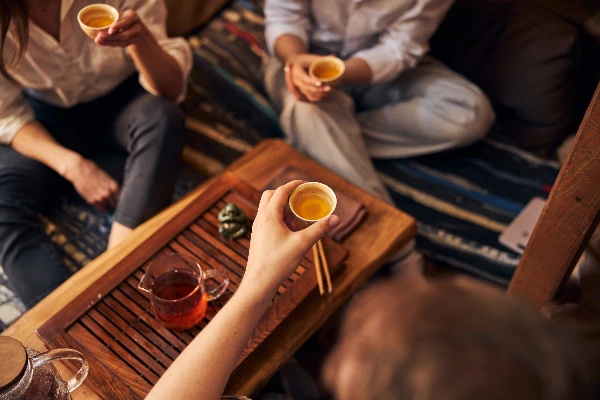
How is tea produced?
So you’re curious about tea production, eh? It’s not just throwing leaves in hot water and calling it a day. Nope, creating this beloved beverage involves several precise steps that get us that perfect cuppa. Here’s the scoop.
The tea-making process is like preparing for a big performance. Each phase is critical, starting from harvesting and going through withering, rolling, oxidation, and firing. It’s a journey from leaf to lovable brew. Let me break it down for you.
What are the key steps in tea production?
Tea production involves several key steps that transform the leaves of the Camellia sinensis plant into the final product we brew. Here are the main stages:
- Harvesting: When picking leaves, it’s all about timing and talent. Workers hand-pluck or machine-harvest only the top two leaves and a bud. It’s like selecting the Avengers, but for tea.
- Withering: This phase involves spreading the freshly picked leaves to let them lose moisture. Think of it as laying out your clothes to air-dry. The leaves become soft and pliable, ready for the next step.
- Rolling: Here, the leaves are twisted and crushed to break down the cell walls, allowing essential oils to be released. Imagine kneading dough—you’re making those flavours come out.
- Oxidation: Depending on the type of tea, the oxidation process may vary. The leaves are left to react with oxygen, darkening in colour and deepening in flavour. It’s like letting a good story unfold.
- Firing: Finally, the leaves are heated to halt oxidation and remove any remaining moisture. This is like sealing the letter before sending it; it locks in the essence.
How does the production process vary between different types of tea?
The same steps, but executed like they’re playing different musical instruments.
- Green Tea: Minimal oxidation. The leaves go through quick firing or steaming right after withering. Think of it as a no-nonsense, get-to-the-point process.
- Black Tea: Full oxidation. The leaves are left to darken completely before firing. It’s a slow-cooked dish, allowing deep, rich flavours to develop.
- Oolong Tea: Partial oxidation. This tea type sits in between green and black, with oxidation halted at around 20%-80%. It’s like a teenager figuring out its identity—complex and evolving.
- White Tea: The least processed, only withered and dried. Picture it as the minimalist of teas, retaining a delicate flavour.
- Pu-erh Tea: Fermented and aged. The leaves undergo microbial fermentation, creating a tea that gets better with time, much like fine wine.
What impact does production have on flavour?
How you handle those precious leaves makes all the difference in the world.
- Harvesting: Freshness matters. Leaves plucked expediently at the peak time yield vibrant flavours.
- Withering: Controls the moisture level, laying the groundwork for the final taste. Dry vs. moist? It’s a game-changer.
- Rolling: Brings out the essential oils, the very soul of the tea flavour. Roll it the right way, get an aromatic delight.
- Oxidation: Dictates the depth and intensity of the tea. More oxidation means darker, stronger flavour notes.
- Firing: Seals the deal, locking in all those characteristics. Skimp on this, and you might end up with a soggy mess rather than a refreshing brew.
To truly appreciate the complexity of this process, let’s take a trip back to the Tang Dynasty in China. The Chinese poet Lu Yu wrote “The Classic of Tea” in the 8th century, detailing the art and philosophy of tea.
His work highlighted the meticulous care needed at each stage, reflecting how pivotal these steps were even back then. Imagine, centuries ago, they were already perfecting these methods, paving the way for the global tea culture we cherish today.
Can you see why tea production is such a big deal now? It’s not just a drink—it’s an art form finely tuned over centuries. From your daily brew to exotic varieties, every sip narrates a story crafted through time and tradition.
What is the cultural significance of tea in different societies?
Tea is more than just a drink, it’s a cultural phenomenon that has woven itself into the fabric of societies around the world. From elaborate ceremonies to simple social gatherings, tea has played a pivotal role in shaping traditions, customs, and even historical events. Buckle up, because we’re about to dive into how this humble leaf has left an indelible mark on various cultures.
Across the globe, tea ceremonies and rituals have become an integral part of social life. Whether it’s the serene Japanese tea ceremony, the sophisticated British afternoon tea, or the diverse regional customs, tea has found a special place in the hearts of many. You might not think much of that cup of tea you drink in the morning, but it’s steeped in rich cultural significance.
How is tea celebrated in Japanese culture?
In Japan, tea isn’t just a beverage, it’s an art form and a spiritual experience. Japanese tea ceremonies, or “chanoyu,” epitomise grace, etiquette, and mindfulness. Imagine a room so silent you can hear a pin drop, where every movement is executed with precision and poise. It’s like a slow dance, but with tea utensils.
- Ceremonial Bowls: These intricately designed bowls aren’t just for drinking. They symbolize the care and artistry that goes into the ritual.
- Matcha Tea: The star of the show. This powdered green tea is whisked in a bowl until it froths, creating a drink that’s both invigorating and calming.
- Quietude: Every sip is taken in silence, reflecting on harmony and the beauty of simple things.
- Zen Philosophy: The ceremony often takes place in a tea room with a tatami mat, highlighting Japanese aesthetics and Zen principles.
- Seasonal Flowers: The tea room decor changes with the seasons, adding an extra layer of mindfulness and appreciation for nature.
The Japanese tea ceremony is an immersive experience that transcends mere drinking. It embodies the principles of tea as a form of meditation, bringing people closer to nature and each other.
Ah, the Brits and their tea. This isn’t just about dunking a teabag in hot water; it’s practically a national pastime. British people have elevated tea drinking to a fine art that permeates social life.
- Afternoon Tea: Picture a three-tiered stand overflowing with scones, clotted cream, and finger sandwiches. It’s as much about the food as it is about the tea.
- Tea Parties: Think less rave, more refined gathering. Tea parties are a way to socialise with a touch of elegance.
- The Great British Cuppa: The British enjoy their tea any time of day, often with a splash of milk and a generous helping of biscuits.
- Cultural Symbol: Tea has become synonymous with British identity, representing hospitality, comfort, and tradition.
- Royal Connections: Afternoon tea was popularised by the Duchess of Bedford in the early 19th century and has been a staple ever since.
For Brits, tea serves as a social lubricant, a comforter in times of distress, and a reason to gather. It’s the cornerstone of British hospitality and can resolve almost any problem, big or small.
How has tea influenced cultural practices globally?
Tea has woven its way through the historical and cultural tapestry of numerous countries, leaving behind a trail of tea leaves and rich traditions. Globally, tea isn’t just a drink; it’s a lifestyle.
- Chinese Traditions: China, the birthplace of tea, has a deeply ingrained tea culture. Gongfu Tea Ceremony is a methodical and intricate process.
- Indian Chai: Masala chai, with its aromatic spices, is an everyday ritual in India, sold in clay cups by street vendors.
- Moroccan Mint Tea: In Morocco, mint tea isn’t just a drink but a gesture of hospitality and friendship.
- Russian Samovar: In Russia, tea is brewed using a samovar, and it’s often served strong and sweet with lemon.
- Turkish Tea: Known as “çay,” this tea is a staple in Turkish households and is often brewed in a special double teapot.
Tea has influenced everything from social structures and hospitality traditions to religious practices and historical events. It’s been the catalyst for trade, the bridge between cultures, and the comfort in solitude.
During the Tang Dynasty in China, tea became a drink of the elite, a reflection of the immense value placed on it. Emperor Huizong of the Song Dynasty was even known to meticulously document tea preparation techniques, elevating the process to an art form.
This wasn’t just any emperor; Huizong was an artist and poet who saw beauty in the everyday ritual of tea, reinforcing its cultural importance. So, next time you sip tea, remember that this simple act connects you to a vast and fascinating history.
What are common misconceptions about tea?
Let’s bust some myths, shall we? Tea has been around for thousands of years, yet we still manage to get some basic facts wrong about it. People have wild ideas such as all teas being caffeinated, assuming herbal teas are the real deal, and even thinking tea could be more harmful than helpful. Let’s sift through these misconceptions and spill the tea on tea!
First off, not all teas are created equal when it comes to caffeine. There’s a massive variety of teas, each one different in taste, aroma, and yes, caffeine content. Secondly, when it comes to herbal teas, let’s get something straight: they aren’t really teas. Health-wise, tea can be your best friend or your worst enemy, depending on how you consume it.
Is all tea caffeinated?
The simple answer? No way. If you’re thinking that every cup of tea is going to give you a caffeine jolt, you need a reality check. Only some teas contain caffeine, and even those vary widely in their caffeine content.
- Black tea: This has the most caffeine of the lot, comparable to about half a cup of coffee.
- Green tea: Contains less caffeine than black tea, but still enough to give you a gentle lift.
- White tea: Even milder caffeine content, so perfect for those who want to take it easy.
- Oolong tea: Falls somewhere between green and black tea in terms of caffeine.
- Herbal teas: Totally caffeine-free, as they’re made from herbs, spices, and flowers, not the actual tea plant.
So, if you’re jittery about caffeine, you’ve got options. You don’t need to swear off tea completely—just choose wisely.
Are herbal teas considered real teas?
Brace yourself: Herbal teas aren’t real teas. I know, it sounds like a scandal, but it’s the truth. The term “tea” should technically only apply to beverages made from the Camellia sinensis plant.
- Chamomile: Popular for its calming properties, but definitely not tea.
- Peppermint: Refreshing, yes. Real tea, no.
- Rooibos: South African and caffeine-free, but again, not the real deal.
- Hibiscus: Tart and tangy, still just a herbal infusion.
- Ginger tea: Great for the tummy, purely herbal.
So while herbal “teas” offer fantastic flavours and health benefits, they’ve been posing as tea imposters all along.
Can tea be harmful to health?
Tea is like that enigmatic friend who’s mostly great but occasionally problematic. So yes, under certain circumstances, it can be harmful to health. But don’t panic just yet.
- Tannins: These can inhibit iron absorption, which might be an issue if you’re anaemic.
- Caffeine: Too much can lead to sleep problems, jitters, and rapid heartbeat.
- Sugar: Adding heaps of sugar turns your healthy drink into a calorie bomb.
- Fluoride: High levels can accumulate in your bones and joints over time.
- Contaminants: Poor quality tea might contain pesticides or heavy metals.
The key here is moderation and selection. High-quality tea consumed in reasonable amounts can be part of a healthy lifestyle. Ditch the sugar and go for reputable brands to sip safely.
Back in the 1600s, tea took England by storm. But did you know that tea almost didn’t make it across the channel? It was all thanks to a woman, Catherine of Braganza, the Portuguese princess who married King Charles II.
Her love for tea brought the exotic beverage to the English court, initiating what would become an entire nation’s obsession. So the next time you sip your Earl Grey, remember that it’s good ol’ Catherine you’re toasting to. Cheers!
How to choose the right tea for your needs?
Do you ever stand in the tea aisle, staring at the rows of boxes as if they hold the secrets of the universe? You’re not alone. Navigating the world of tea can be like trying to find a gem in a pile of rocks, but let’s break it down, step by step, so you can become a tea connoisseur.
First things first, choosing the right tea for you involves a few key factors – flavour preferences, health benefits, caffeine levels, and brewing methods. Because not all teas are created equal, knowing what you like and need is half the battle.
What should I consider when choosing a tea?
When on a tea hunt, it’s almost like dating – you want to find the perfect match that suits your style. Here’s what you need in your shopping cart:
- Flavour preferences: Are you all about that robust, earthy taste or fancy something light and floral? Black tea can be as bold as a knight’s battle cry, whereas green tea tends to be more mellow with a grassy note. Herbal teas like chamomile? Pure floral bliss.
- Health benefits: Different teas come with different health perks. Green tea boosts metabolism and fights off rogue radicals, while peppermint tea can calm that pesky irritable bowel.
- Caffeine levels: If you’re prone to nightly wanderings and don’t want to add insomnia into the mix, pay attention to caffeine. Black tea packs a punch, whereas green tea is more like a gentle nudge. For a caffeine-free snooze-friendly option, go herbal.
- Brewing methods: Are you a tea bag dipper or a loose-leaf aficionado? Each tea has its optimal brewing method. Some need boiling water, some a bit below boiling, and let’s not even get started on steeping times.
Now, don your detective hat and figure out what floats your boat, health-wise and flavour-wise. Arm yourself with this guide, and you’ll go from a confused rookie to a savvy tea master in no time.
How do different teas affect health?
Let’s not beat around the bush: you probably know that some teas give you more than just a tasty hug in a mug. Tea can be your secret health weapon.
- Green tea: High in antioxidants, this green elixir fights fat, enhances brain function, and has been linked to lower cancer risks.
- Black tea: Packed with flavonoids, it’s good for heart health and can lower cholesterol levels. Also, it keeps you sharp.
- Herbal tea: Varied and vibrant – think chamomile for relaxation, peppermint for digestion, and ginger for a good ol’ anti-inflammatory kick.
- Oolong tea: Straddles the line between green and black tea. It’s handy for weight management and lowering bad cholesterol.
From antioxidants that fight off cell-damaging free radicals to polyphenols targeting the heart, tea is nature’s brew of health splurges. Be it from soothing stress, aiding digestion, to whipping up mental alertness – a cup of tea is more than just comfort, it’s practically medicinal.
What is the best brewing method for different teas?
You’ve picked your tea, now let’s get brewing like a pro. The wrong method can turn your promising tea into bitter disappointment. Here’s the key to making sure each cup is absolute perfection:
- Black tea: Use freshly boiled water and steep for 3-5 minutes. Resist the temptation of over-steeping unless you enjoy sipping on battery acid.
- Green tea: Water temperature should be 70-80°C, and steep for 2-3 minutes. Any hotter, and you’ll burn the leaves, making them as bitter as unfulfilled dreams.
- Herbal tea: Boiling water is your friend here, steep for 5-7 minutes. No worries about bitterness, just pure herbal goodness.
- Oolong tea: Similar to green tea, use 80-90°C water and steep for 4-7 minutes. Oolong can take a bit more time, so get comfy.
Remember that patience is your lockpick in unleashing the divine flavours. Too hot or over-steeped, and you can kiss your perfectly balanced cup goodbye. Ensure you brew it right to unlock the full potential of the leaves.
Did you know that Catherine of Braganza, the Portuguese princess who married Charles II, is credited with making tea popular in England in the 17th century? She brought her love of the brew with her, and it quickly took hold amongst the English aristocracy.
If it weren’t for her, we might all be quaffing something far less satisfying today. So, next time you sip a calming cup, give a little nod to the historical tea influencer.
What are the best practices for brewing tea?
When it comes to brewing the perfect cup of tea, the devil is in the details. Whether you’re a novice or a budding tea connoisseur, nailing the right water temperature, steeping time, and tea-to-water ratio can make a world of difference. Yes, it’s a bit more complicated than just dunking a teabag in hot water and hoping for the best.
Figuring out the best methods for brewing tea can turn your run-of-the-mill cuppa into an exquisite experience. Fancy it up with knowledge about the specifics and become the tea maestro among your friends. The holy trinity of tea brewing revolves around three crucial factors:
- Water temperature – no, boiling water isn’t always the answer.
- Steeping time – because who wants a tea that’s more bitter than a bad breakup?
- Tea-to-water ratio – measure it right or risk having something only vaguely resembling tea.
Let’s dive in and sip on that tea wisdom!
How does water temperature affect tea flavour?
First off, water that’s too hot can scorch the delicate leaves and ruin the nuanced flavours. Think of it like overcooking your pasta – nobody wants that mushy mess. Each type of tea has its own personality and prefers a specific temperature.
- Green Tea: Likes its water around 70-80°C (158-176°F). Anything hotter is a crime against tea humanity.
- Black Tea: Can handle the heat around 90-100°C (194-212°F). This sturdy chap thrives in boiling water.
- White Tea: Prefers a gentler touch, around 65-75°C (149-167°F). Too hot and you lose its subtlety.
- Oolong Tea: Needs a Goldilocks zone, roughly between 80-85°C (176-185°F). Not too hot, not too cold.
- Herbal Tea: Can take the boil, roughly around 90-100°C (194-212°F). These robust brews won’t back down.
So yes, whip out that fancy thermometer or eyeball it like a pro. Get it wrong, and you’re just sipping on bitter disappointment.
What is the ideal steeping time for different types of tea?
Moving on to the unsung hero of tea brewing – steeping time. Over-steep and your tea turns into a tannin-filled disaster. Under-steep and it tastes like murky water. Each tea type has its unique preference here too.
- Green Tea: Steep for 2-3 minutes. Too long, and hello bitterness!
- Black Tea: Give it 3-5 minutes. Any longer, and it’s going to be as dark as your worst secrets.
- White Tea: Keep it to 4-5 minutes. Too short, and it’s almost flavourless.
- Oolong Tea: Needs 4-7 minutes. These leaves can handle some extra time.
- Herbal Tea: Can steep for 5-7 minutes, but some can go even longer. These aren’t shy leaves.
Finding that sweet spot can turn you into the envy of anyone still using a microwave to reboil water.
How do I measure tea for brewing?
Last but not least, the proper amount of tea to use. This isn’t some random guesswork; get it wrong, and you’re wasting either good tea or clean water.
- Green Tea: Use about 1 teaspoon per 240 ml (8 oz) of water. Too much and it’s like chewing on a tree.
- Black Tea: Also about 1 teaspoon per 240 ml (8 oz). Steep those hearty leaves moderately.
- White Tea: Needs more love, using roughly 2 teaspoons per 240 ml (8 oz). These lighter leaves need more.
- Oolong Tea: About 1-2 teaspoons per 240 ml (8 oz). The variance is because of its semi-oxidised state.
- Herbal Tea: Depending on the blend, usually 1.5 teaspoons per 240 ml (8 oz) of water.
Use a spoon, a scale, whatever floats your boat, but do it right. Treat your tea with the reverence it deserves.
Once upon a time in the 17th century, Catherine of Braganza, the Portuguese princess who married England’s King Charles II, brought tea to the British court. The queen’s fondness for tea turned it from a peculiar foreign drink into a royal favourite. She undoubtedly adhered to some meticulous tea-brewing practices, setting the stage for Britain’s love affair with tea. So next time you brew, channel that royal precision and elevate your tea game. Cheers!
Conclusion
As I reflect on the intricate tapestry that is tea, I am reminded of its profound historical significance, diverse types, and the myriad health benefits it offers. The journey of tea, originating in ancient China and traversing continents, reveals a rich narrative of cultural exchange, trade, and adaptation. It has evolved from centuries-old rituals into a staple of modern lifestyles, illustrating how a simple leaf can have a breathtaking impact on societies worldwide.
Understanding the variety of tea—whether it’s the robust black, the delicate white, or the fragrant herbal blends—enhances our appreciation not only for their unique flavours but also their specific health benefits. From boosting heart health to providing antioxidants, tea indeed serves as a remarkable elixir for wellness.
Delving into the production process further sheds light on the care and expertise involved in crafting each cup. It is fascinating to note how small variations in the production methods can produce such diverse flavours, a testament to the artistry behind each type of tea.
Moreover, tea is not merely a beverage but an integral part of cultural identity across the globe. From the tranquil ceremonies in Japan to the vibrant social gatherings in Britain, tea plays a central role in bonding and celebrating community. Yet, in amidst all this, it’s crucial to navigate the common misconceptions that surround tea—such as its caffeine content or the legitimacy of herbal teas—so we can embrace this versatile drink to its fullest potential.
As you embark on your personal journey with tea, I encourage you to explore its many varieties and understand what resonates with your preferences and health goals. Consider what captivates your senses, and don’t hesitate to experiment with brewing techniques to uncover the perfect cup.
In a world that often rushes past, tea invites us to pause, reflect, and connect, both with ourselves and those around us. As we sip our favourite brews, let us cherish the history, the cultural significance, and the health benefits that come with each cup. Remember, as the ancient Japanese proverb suggests, “Tea is the magic elixir of the gods.” So, what tea will you choose to enjoy today?
Resources
- Common questions and misconceptions about caffeine … – PubMed
- Common questions and misconceptions about caffeine … – ResearchGate
- The anti-obesity effects of green tea in human intervention … – Nature
- Therapeutic effect of high-dose green tea extract on weight … – PubMed
- Causal relationship between tea intake and cardiovascular diseases: A …
- Antioxidant mechanism of tea polyphenols and its impact on health benefits
- Beneficial effects of green tea: A literature review – PMC
- The Power of Antioxidant: Tea Catechin and Body Oxidative Stress


